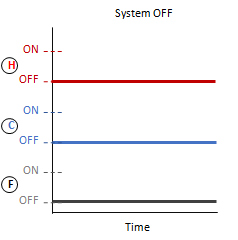Typical HVAC Behavior (No Device Installed)
The following graphs represent the typical behavior of a thermostat and different HVAC systems. These work together to provide temperature control in a room.
Signals from Thermostat to HVAC system:
Note: When the compressor is turned ON, the Fan will always be ON.
Thermostats may apply a duty cycle, or a short cycle protection delay during use of the compressor.
In Heat Pump systems, the compressor provides heat or cool (depending on selected settings).
Signals from Thermostat to HVAC system:
Signals from External Heating Source Connected to HVAC system in Gas Settings
– – – Fan Signal (F)
Thermostats may apply a duty cycle, or a short cycle protection delay during use of the compressor.
In Heat Pump systems, the compressor provides heat or cool (depending on selected settings).
Signals from Thermostat to HVAC system:
Note: When the compressor is turned ON, the Fan will always be ON.
Thermostats may apply a duty cycle, or a short cycle protection delay during use of the compressor.
In Heat Pump systems, the compressor provides heat or cool (depending on selected settings).



